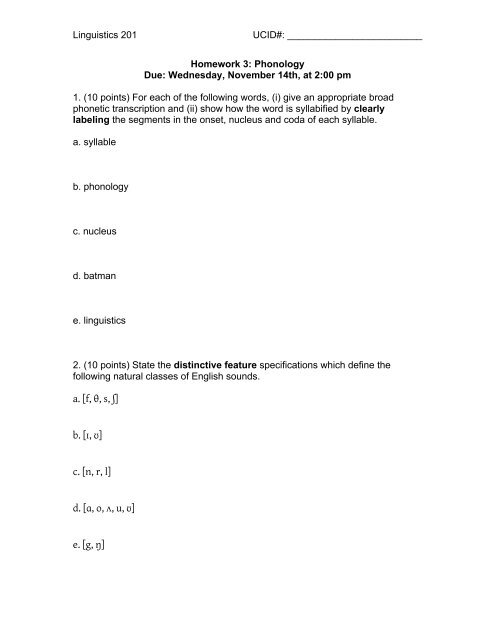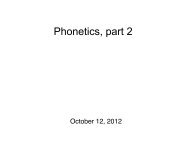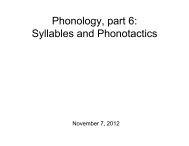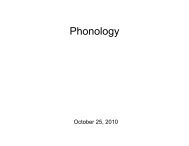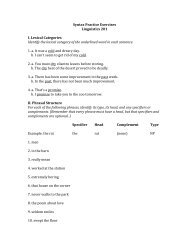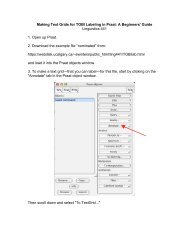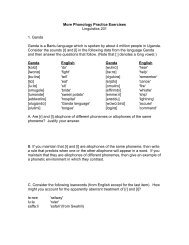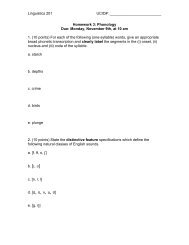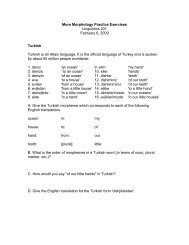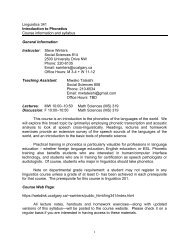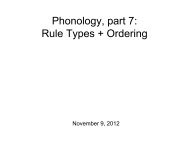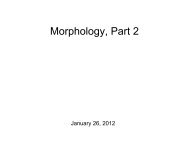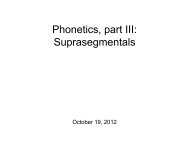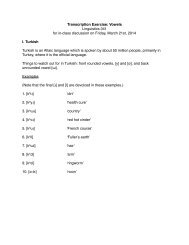Phonology - Basesproduced.com
Phonology - Basesproduced.com
Phonology - Basesproduced.com
Create successful ePaper yourself
Turn your PDF publications into a flip-book with our unique Google optimized e-Paper software.
Linguistics 201UCID#: _________________________Homework 3: <strong>Phonology</strong>Due: Wednesday, November 14th, at 2:00 pm1. (10 points) For each of the following words, (i) give an appropriate broadphonetic transcription and (ii) show how the word is syllabified by clearlylabeling the segments in the onset, nucleus and coda of each syllable.a. syllableb. phonologyc. nucleusd. batmane. linguistics2. (10 points) State the distinctive feature specifications which define thefollowing natural classes of English sounds.a. [f, θ, s, ʃ]b. [ɪ, ʊ]c. [n, r, l]d. [ɑ, o, ʌ, u, ʊ]e. [g, ŋ]
Linguistics 201UCID#: _________________________3. Phonological Processes (5 points)Below are some English words transcribed as they would be pronounced informal speech and in casual speech (by some, but not all speakers of English).Each word undergoes a change from formal speech to casual speech whichexemplifies a phonological process that we have discussed in class. Name thephonological process at work in each example.Spelling Formal Speech Casual Speech Processi) 'balloon' [bʌlu:n] [blu:n]ii) 'gun powder' [gʌnpawɾr̩] [gʌmpawɾr̩]iii) 'diphthong' [dɪfθɑŋ] [dɪpθɑŋ]iv) 'asterisk' [æstʌrɪsk] [æstʌrɪks]v) 'else' [ɛls] [ɛlts]4. Burmese (5 points)The data below <strong>com</strong>e from Burmese, a Sino-Tibetan language spoken insoutheast Asia by about 32 million people.[ma] ‘health’ [na] ‘pain’[nwe] ‘to flex’ [n̥wej] ‘heat (verb)’[n̥ej] ‘unhurried’ [mḁ] ‘order’[m̥i] ‘flame’ [nwa] ‘cow’[mjiʔ] ‘river’ [nḁ] ‘nostril’[m̥on] ‘flour’ [mi] ‘five’Determine whether the sounds [n], [m], [n̥] and [m̥] are allophones of the samephoneme or separate phonemes. If the sounds are separate phonemes, providea minimal pairs which show the contrast between them. If the sounds areallophones of the same phoneme, give:(i) the basic and restricted allophones(ii) the environment in which the restricted allophone appears(iii) the phonological rule accounting for the change between allophones
Linguistics 201UCID#: _________________________5. Dialects of English (5 points)One feature that distinguishes the American and British dialects of English is thedistribution of the [ju:] sequence. The data below show that this sequencesometimes does not appear in the American pronunciation of certain words, eventhough it does appear in the British pronunciation of the same words. (Note thatsome Canadian speakers follow the American pattern, and other Canadianspeakers follow the British pattern.)Word American Pronunciation British Pronunciation‘amuse’ [ʌmju:z] [ʌmju:z]‘beauty’ [bju:ɾi] [bju:ɾi]‘cube’ [k h ju:b] [k h ju:b]‘dupe’ [du:p] [dju:p]'enthused' [ɛnθu:zd] [ɛnθju:zd]‘fume’ [fju:m] [fju:m]‘lurid’ [lu:rɪd] [lju:rɪd]‘news’ [nu:z] [nju:z]‘puny’ [p h ju:ni] [p h ju:ni]‘presume’ [p h rʌzu:m] [p h rʌzju:m]‘stupid’ [stu:pɪd] [stju:pɪd]‘suit’ [su:t] [sju:t](i) In what phonetic environment does [ju:] appear in the British pronunciations ofthese words, but not in the American pronunciations? The conditioningenvironment involves a natural class of sounds; state what that natural class is.(ii) Assuming that the underlying phonemic form in both dialects is /ju:/, write aformal phonological rule which accounts for the changes in the Americanpronunciation.
Linguistics 201UCID#: _________________________6. Spanish (5 points)Consider the sounds [d] and [ð] the data from Spanish below and then answerthe questions that follow. (Note that the Spanish [r] is phonetically different fromEnglish [r], but that fact is irrelevant to the solution of this problem.)[drama] 'drama' [komiða] 'food'[dolor] 'pain' [anda] 'scram'[dime] 'tell me' [sueldo] '<strong>com</strong>pensation'[kaða] 'each' [durar] 'to last'[laðo] 'side' [toldo] 'curtain'[oðio] 'hatred' [falda] 'skirt'Are the sounds [d], [ð] allophones of the same phoneme or separate phonemes?If the sounds are separate phonemes, provide evidence that there is a contrastbetween them. If the sounds are allophones of the same phoneme, give:(i) the basic and restricted allophones(ii) the environment in which the restricted allophone appears(iii) the phonological rule accounting for the distribution of the allophones
Linguistics 201UCID#: _________________________7. German (5 points)German has two fricatives which do not exist in American English: [ç], avoiceless palatal fricative, and [x], a voiceless velar fricative. Examine the databelow and then answer the questions that follow. (Note that [ɔ] is a mid, back,round vowel.)[axt] ‘eight’ [ɪç] ‘I’[bu:x] ‘book’ [ɛçt] ‘real’[lɔx] ‘hole’ [ʃpre:çə] ‘would speak’[ho:x] ‘high’ [lɛçəln] ‘to smile’[flʊxt] ‘flight’ [fɛçtən] ‘to fence’(i) What distinctive feature distinguishes between palatal and velar sounds?(ii) In German, the fricatives [ç] and [x] are allophones of the same phoneme.Describe the phonetic contexts in which each allophone appears--in the simplestterms possible--using distinctive features.(iii) Write a phonological rule which accounts for the distribution of the twoallophones. (Note that it is not possible to determine, from this data set, whichallophone is basic, so simply choose either allophone as the underlying form andproceed from there.)
Linguistics 201UCID#: _________________________8. Ganda (5 points)Ganda is a Bantu language which is spoken by about 4 million people in Uganda.Consider the sounds [r] and [l] in the following data from the language Gandaand then answer the questions that follow. (Note that [:] denotes a long vowel.)Ganda English Ganda English[kolɑ] 'do' [wulirɑ] 'hear'[lwɑnɑ] 'fight' [be:rɑ] 'help'[bu:lirɑ] 'tell' [dʒukirɑ] 'remember'[ljɑ] 'eat' [erjɑto] 'canoe'[lu:lɑ] 'sit' [omuliro] 'fire'[omugole] 'bride' [effirimbi] 'whistle'[lumonde] 'sweet potato' [emme:ri] 'ship'[eddwɑliro] 'hospital' [erɑddu] 'lightning'[olugɑndɑ] 'Ganda language' [wɑwɑ:birɑ] 'accuse'[olulimi] 'tongue' [lɑgirɑ] '<strong>com</strong>mand'A. Are [r] and [l] different phonemes or allophones of the same phoneme inGanda? Justify your answer.B. If you maintain that [r] and [l] are allophones of the same phoneme, then writea rule that predicts when one or the other allophone will appear in a word. If youmaintain that they are allophones of different phonemes, then give an example ofa phonetic environment in which they contrast.C. Consider the following loanwords (from English except for the last item). Howmight you account for the apparently aberrant treatment of [r] and [l]?le:rwelu:lasaffa:li'railway''ruler''safari' (from Swahili)
Linguistics 201UCID#: _________________________Optional BONUS exercise: Tolkien tongues (2 points)J.R.R. Tolkien was an Oxford philologist who invented his own languages wellbefore he ever became famous for writing books like The Hobbit and The Lord ofthe Rings. He incorporated some of these invented languages into his novels.Below are brief samples of his "Elvish" language (Quenya) and also the "BlackSpeech" of Mordor, both from the book The Fellowship of the Ring.Since Tolkien knew a lot about linguistics, he gave each of his inventedlanguages its own phonetic character, as it were. For this exercise, I want you toquantify the phonetic characters of each language shown below by calculatingthe ratio of sonorant to obstruent consonants in each language sample.(Note: the symbol [ɣ] represents a voiced velar fricative)Language Sample 1: Elvish[ɑ elbereθ gilθoniel silivren pen:a miriel o menel aglar elenaθ]Language Sample 2: Mordorish[aʃ nazg durbatulu:k, aʃ nazg gimbatul, aʃ nazg θrakatulu:k aɣ burzum-iʃi krimpatul]


